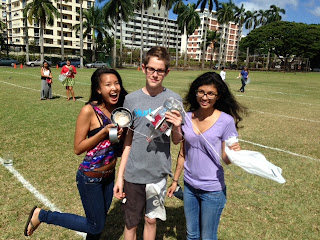One two liter soda bottle
4 triangle shaped 5 by 1.5 inch fins-
A big funnel that we used as our cone
A ball of clay inside the funnel
A piece of saran wrap to cover the clay
A circle shaped parachute made out of a garbage bag
Four long strings attaching the parachute to the rocket
A lot of duct tape
We got our design from instinct and the internet. The internet told us to make triangle shaped fins, but we chose the size of them. We chose poster board for our fin material because we knew it was sturdy and light. Matt brought in the funnel so we used it. We used a ball of clay because a website told us that clay was a good mass to use and it would stay well in the cone. We at first used a glass circle to cover the clay so the parachute wouldn't stick to it, but it didn't work well so we got a piece of saran wrap and covered the clay so it wouldn't stick to the clay. We used a garbage bag because we thought it would be sturdy and a good size. We cut it into a circle because a website told us to, and we knew that a wider parachute was best. At first we had short strings attaching the parachute to the rocket but Mr. Blake told us to change to longer strings when our parachute failed to do well. We used duct tape because duct tape is the strongest tape.
 What worked as planned was the clay, the shape and size of our bottle, and our fins. All these things worked well, and we didn't have trouble with. What didn't work as well was the parachute, the cone, and the strings. The parachute didn't come out more than half of the time. Our small cone broke on our 5th trial because it fell downward and cracked when it hit the ground, good thing we had a bigger cone as a backup. This bigger cone ended up working out much better. It was bigger so that the parachute could fit and open up when in the air. The short strings didn't work yesterday so we got longer strings. The longer strings always got tangled though and on our 16 second trial they got twisted as the rocket was falling down.
What worked as planned was the clay, the shape and size of our bottle, and our fins. All these things worked well, and we didn't have trouble with. What didn't work as well was the parachute, the cone, and the strings. The parachute didn't come out more than half of the time. Our small cone broke on our 5th trial because it fell downward and cracked when it hit the ground, good thing we had a bigger cone as a backup. This bigger cone ended up working out much better. It was bigger so that the parachute could fit and open up when in the air. The short strings didn't work yesterday so we got longer strings. The longer strings always got tangled though and on our 16 second trial they got twisted as the rocket was falling down.PSI: 80
Amount of water: About a liter
Times:
5.59 s
6.71 s
11.87 s
Avg: 8.06 s
8.1 s
5.1 s
6.79 s
9.4 s
5.4 s
16.7 s
Avg: 8.58 s
Project taught us:
Also on the first day we filled our rocket up with 1/3 of water, which was not as successful. On the second day we filled it up with 1/2 of water which resulted in a higher rocket.
For your rocket to go high you also need a high PSI too, more pressure means a higher rocket.
We learned from this project that wider and bigger parachutes were also better. This is because they catch more air and result in a longer falling time.
The cones of our rockets couldn't be too secure on the rocket because as the rocket is going up friction is pushing down super hard on the rocket and for the parachute to work the cone needed to fall off, so you had to be sure your cone was loose.
Longer strings were better because it allowed the parachute to take on more air. Some groups had paper cones, we had a plastic one and ours was more successful because it was stronger against the wind and didn't crush when it fell.





good blogpost candace, we did very well as a group and i think that our rocket did just as expected.
ReplyDelete